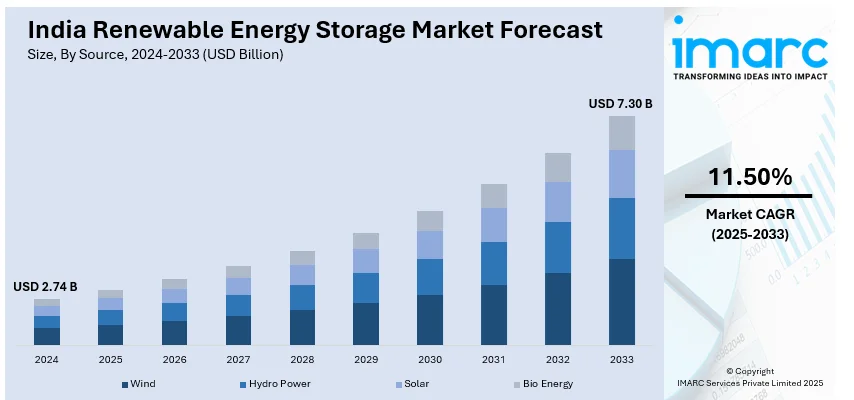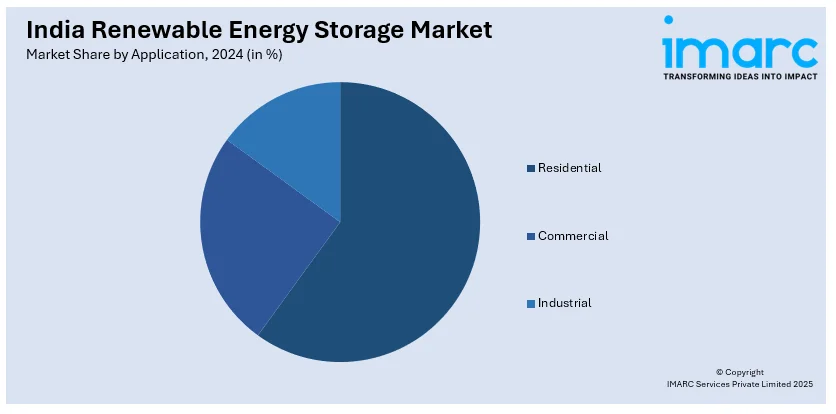
India Renewable Energy Storage Market Size, Share, Trends and Forecast by Source, Technology, Application, and Region, 2025-2033
India Renewable Energy Storage Market Overview:
The India renewable energy storage market size reached USD 2.74 Billion in 2024. Looking forward, IMARC Group expects the market to reach USD 7.30 Billion by 2033, exhibiting a growth rate (CAGR) of 11.50% during 2025-2033. The market is experiencing significant growth, driven by the integration of renewable energy sources, increasing electricity demand, and advancements in storage technologies. Moreover, government initiatives, declining battery costs, and the adoption of electric vehicles are favoring market expansion. Additionally, industrial and commercial sectors are seeking reliable backup power, further fueling market expansion.
|
Report Attribute
|
Key Statistics
|
|---|---|
|
Base Year
|
2024 |
|
Forecast Years
|
2025-2033
|
|
Historical Years
|
2019-2024
|
| Market Size in 2024 | USD 2.74 Billion |
| Market Forecast in 2033 | USD 7.30 Billion |
| Market Growth Rate (2025-2033) | 11.50% |
India Renewable Energy Storage Market Trends:
Surge in Energy Storage Advancements
India is undergoing a significant transition toward sustainable energy solutions, with substantial investments accelerating the development of innovative storage technologies. The focus is on enhancing long-term energy storage, developing lithium-ion battery production, and boosting battery recycling infrastructure. These developments contribute to the increased adoption of sustainable transportation and renewable energy integration. As the country pursues energy independence and decarbonization, increased funding commitments are establishing a robust ecosystem for storage solution innovation. The growing trend for localized manufacturing and recycling aims to reduce reliance on imports while enhancing efficiency and sustainability. With a strong regulatory framework and industry participation, India is positioning itself as a leader in energy storage, ensuring the country's energy security and resilience. For instance, at the 10th India Energy Storage Week (IESW), commitments to invest over INR 2,000 crore were made in energy storage, electric vehicles, and green hydrogen industries. Notable projects included VFlowTech's long-term energy storage facility in Haryana, Nash Energy's lithium-ion battery plant in Karnataka, and BatX Energies' battery recycling facility. These developments position India as a rapidly growing hub for advanced energy solutions.

Advancing Battery Storage for Reliable Power
Energy storage is becoming an increasingly vital component of modern power networks, enhancing stability, efficiency, and the integration of renewable sources. Advancements in battery technology are generating cost savings and broadening access to reliable power. Investments in large-scale storage technologies improve grid resilience, ensure continuous power supply, and contribute to energy transition goals. These advancements are particularly beneficial in regions with high power demand, where storage technologies can balance supply fluctuations while improving cost-effectiveness. As technology progresses and financial support increases, energy storage will play an increasingly crucial role in building a more sustainable and self-sufficient energy future. The shift to new storage systems is a step forward in achieving long-term energy security and efficiency. For example, in February 2025, NTPC announced plans to invest over 2 trillion rupees (USD 23.07 Billion) in renewable energy projects in Madhya Pradesh, focusing on solar, wind, pump hydro, and other carbon-neutral energy sources. One major project includes building up to 20 GW capacity at an investment of 1.2 trillion rupees.
India Renewable Energy Storage Market Segmentation:
IMARC Group provides an analysis of the key trends in each segment of the market, along with forecasts at the region/country level for 2025-2033. Our report has categorized the market based on source, technology, and application.
Source Insights:
- Wind
- Hydro Power
- Solar
- Bio Energy
The report has provided a detailed breakup and analysis of the market based on the source. This includes wind, hydro power, solar, and bio energy.
Technology Insights:
- Pumped Hydroelectric Storage
- Battery Energy Storage
- Flywheel Energy Storage
- Compressed Air Energy Storage
- Thermal Energy Storage
- Hydrogen Energy Storage
A detailed breakup and analysis of the market based on the technology have also been provided in the report. This includes pumped hydroelectric storage, battery energy storage, flywheel energy storage, compressed air energy storage, thermal energy storage, and hydrogen energy storage.
Application Insights:

- Residential
- Commercial
- Industrial
A detailed breakup and analysis of the market based on the application have also been provided in the report. This includes residential, commercial, and industrial.
Regional Insights:
- North India
- South India
- East India
- West India
The report has also provided a comprehensive analysis of all the major regional markets, which include North, South, East, and West India.
Competitive Landscape:
The market research report has also provided a comprehensive analysis of the competitive landscape. Competitive analysis such as market structure, key player positioning, top winning strategies, competitive dashboard, and company evaluation quadrant has been covered in the report. Also, detailed profiles of all major companies have been provided.
India Renewable Energy Storage Market News:
- In March 2025, Tata Power Renewable Energy Ltd (TPREL) announced a significant investment of USD 5.63 Billion to establish 7 gigawatts (GW) of green energy projects in Andhra Pradesh, encompassing solar, wind, and hybrid energy solutions. This initiative aligns with India's broader goal to achieve 500 GW of non-fossil fuel electricity generation capacity by 2030.
- In December 2024, LG Energy Solution and India's JSW Energy discussed a USD 1.5 Billion joint venture to manufacture batteries for electric vehicles and renewable energy storage, aiming to establish a 10 GWh capacity plant by the end of 2026.
India Renewable Energy Storage Market Report Coverage:
| Report Features | Details |
|---|---|
| Base Year of the Analysis | 2024 |
| Historical Period | 2019-2024 |
| Forecast Period | 2025-2033 |
| Units | Billion USD |
| Scope of the Report |
Exploration of Historical Trends and Market Outlook, Industry Catalysts and Challenges, Segment-Wise Historical and Future Market Assessment:
|
| Sources Covered | Wind, Hydro Power, Solar, Bio Energy |
| Technologies Covered | Pumped Hydroelectric Storage, Battery Energy Storage, Flywheel Energy Storage, Compressed Air Energy Storage, Thermal Energy Storage, Hydrogen Energy Storage |
| Applications Covered | Residential, Commercial, Industrial |
| Regions Covered | North India, South India, East India, West India |
| Customization Scope | 10% Free Customization |
| Post-Sale Analyst Support | 10-12 Weeks |
| Delivery Format | PDF and Excel through Email (We can also provide the editable version of the report in PPT/Word format on special request) |
Key Questions Answered in This Report:
- How has the India renewable energy storage market performed so far and how will it perform in the coming years?
- What is the breakup of the India renewable energy storage market on the basis of product type?
- What is the breakup of the India renewable energy storage market on the basis of application?
- What are the various stages in the value chain of the India renewable energy storage market?
- What are the key driving factors and challenges in the India renewable energy storage market?
- What is the structure of the India renewable energy storage market and who are the key players?
- What is the degree of competition in the India renewable energy storage market?
Key Benefits for Stakeholders:
- IMARC’s industry report offers a comprehensive quantitative analysis of various market segments, historical and current market trends, market forecasts, and dynamics of the India renewable energy storage market from 2019-2033
- The research report provides the latest information on the market drivers, challenges, and opportunities in the India renewable energy storage market.
- Porter's Five Forces analysis assist stakeholders in assessing the impact of new entrants, competitive rivalry, supplier power, buyer power, and the threat of substitution. It helps stakeholders to analyze the level of competition within the India renewable energy storage industry and its attractiveness.
- Competitive landscape allows stakeholders to understand their competitive environment and provides an insight into the current positions of key players in the market.
Need more help?
- Speak to our experienced analysts for insights on the current market scenarios.
- Include additional segments and countries to customize the report as per your requirement.
- Gain an unparalleled competitive advantage in your domain by understanding how to utilize the report and positively impacting your operations and revenue.
- For further assistance, please connect with our analysts.
 Inquire Before Buying
Inquire Before Buying
 Speak to an Analyst
Speak to an Analyst
 Request Brochure
Request Brochure
 Request Customization
Request Customization




.webp)




.webp)












